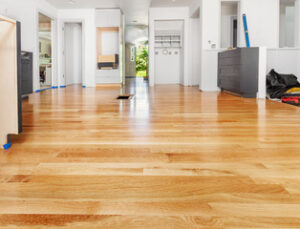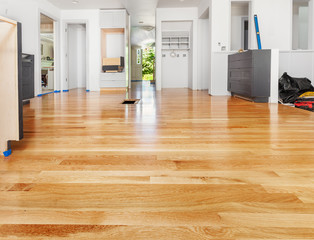If you have a drab-looking floor that looks like it could use some love, refinishing your hardwood floors is an affordable way to restore their appearance and extend the life of your floors.
Whether you want to stain your floors or varnish them, it’s important to choose the right products. This will determine how the finished floor looks and how it protects your wood flooring.
Staining hardwood floors is a simple and affordable way to add color to your home. It also provides protection against sun damage, which can cause discoloration and cracks on your floor.
Stains come in a variety of tints and colors to match the natural tone of your wood flooring. Brown tones and neutrals offer a timeless look that can complement any decor.
Water-based stains are the most popular choice because they are easy to apply and clean up. They also provide a durable finish that resists scuffing and scratching.
Before staining, be sure to remove any existing finishes or coatings from your floor and make sure it is completely dry. This is particularly important if you are planning to use a polyurethane sealer.
Next, apply a generous coat of stain in the direction of the wood grain. Allow the stain to dry for a few minutes. Wipe off any excess with a cloth or paper towel.
For best results, work on one small area at a time. Ensure that you move in the same direction as the wood grain to avoid cross-grain swipe marks.
After the stain dries, you can apply a polyurethane finish to protect your floor and enhance its color. Apply a thin layer with a high-density foam roller or two-inch brush, and then wipe it off.
Keep in mind that some stains require multiple coats to achieve the desired effect. This is due to the different levels of moisture and temperature that can affect a stain’s drying process. Ideally, allow at least 48 hours for the first coat to dry before applying a second coat.
Varnish is a finishing product that can be applied to hardwood floors to give them a new look. It can also be used to protect hardwood floors from water and stains.
Varnish has a higher ratio of solids than polyurethane, which makes it less susceptible to UV damage. It also offers more color options and durability than polyurethane.
To ensure you have the proper materials for your refinishing project, check with a local hardware store to learn about which type of finish is best for your particular wood species. For example, if your floor is made of mahogany or oak, you may want to choose an oil-based polyurethane.
If your flooring is made of maple or ash, you may be better off with a water-based polyurethane. You’ll need to consider the amount of traffic your floor gets and if you prefer a matte or glossy finish.
Before applying a coat of varnish, you’ll need to sand the floor. This will help you remove scuff marks and other imperfections, giving the floor a smooth, even surface to which the finish can adhere.
After sanding, you can apply multiple coats of varnish. Make sure to sand your floor with 220-grit paper before each application. You’ll also need a lamb’s wool applicator for a smooth, even coat.
You can also refinish your floors by applying a natural, mineral-based product called aluminum oxide. This coating has a very high degree of UV protection, which can be useful for preventing scratches and scuffing on wood floors.
The refinishing process may be time-consuming and labor-intensive, but it’s worth the effort. You’ll get a gorgeous, smooth, and polished finish that will last for years to come.
There are a few different types of brushes used by hardwood floor refinishers. They include soft bristle brushes, which are ideal for use on softer floors, and stiffer brushes, which are better for more durable flooring surfaces.
The best brush for refinishing is a brush with natural tampico bristles, which help to remove dust and dirt from delicate surfaces. The bristles are also strong enough to handle the job without scratching or damaging the wood.
Tampico is a natural plant fiber that absorbs water better than plastic bristles. It’s also more sustainable, so it’s a good option for those interested in the environment.
Using a tampico brush on your floor before staining is an excellent way to prevent grain rise, which is when tiny little fibers become visible on your floors after you’ve sanded them. Getting rid of the grain raise can make your floor look more uniform and smooth.
It’s also important to choose the right type of refinishing finish for your flooring. Some finishes, like polyurethane, are more durable than others and can last for years. Other finishes, such as acid-cured, are a little harder to apply and may be difficult to maintain.
Refinishing your floors can be an overwhelming project, but it’s also a great opportunity to update the look of your home. You can do it yourself if you have the patience and space, or you can hire a professional to handle it for you.
It’s important to sand your floors down before you begin applying any new finish to them. This will help the finish to adhere to the wood and prevent it from peeling off when you walk on it. It will also make it easier to reapply the finish.
Hardwood floors are beautiful and long-lasting, but they can lose their luster after years of use. When this happens, you can refinish the floor to restore its beauty and protect it from future wear and tear.
Refinishing wood floors requires several different tools, depending on the type of floor you have. Generally, solid hardwood flooring is best for refinishing, as it is made of a single plank of wood that is at least 3/4-inch thick. Other types of flooring, such as engineered hardwood, may be more difficult to refinish because they are made up of individual layers of thin wood.
The first step in refinishing your floor is to remove the old finish. You can do this by using a sander or a scraper. Sanding can help remove the finish and create a smooth surface for the new floor coating.
You can rent a drum sander or an edge sander for this task. The drum sander is useful for sanding the main part of the floor, while the edge sander is used to sand around baseboards and corners.
After sanding, you can apply a coat of polyurethane to the floor. The polyurethane will prevent the floor from absorbing moisture and help it dry faster. It is also self-leveling, which makes it easier to sand the floor and achieve a smooth surface.
Lastly, you can use a revitalizer gloss to make the finish look new again. Revitalizers contain chemicals that bind to the existing coating to make it stronger. They can be used on both new and older floors.
Hardwood floor refinishers take many safety measures when they work on the floors in your home. These include wearing tough boots that can withstand a variety of conditions and using a good dust mask to protect your eyes from chemical fumes.
Moreover, they make sure to have containment systems in place to keep the air clean and free of dust before they begin working. This will prevent any particles or chemicals from getting into the room and causing fires, which are the most common reason why hardwood floors burn in homes.
In addition to taking these precautions, they also make sure that the wood they work with is a good match for the job. Choosing the right type of wood will help them finish your floors faster and more efficiently.
If you have hardwood floors that need refinishing, it is best to do so as soon as possible before they get too damaged. This will prevent them from deteriorating further and requiring a costly repair or replacement.
The first step in refinishing is to remove all of the existing finish from the wood. This involves sanding down the old coat of polyurethane or stain.
After sanding, it is important to clean the floor thoroughly to remove any dirt and other debris. This will allow the new stain or finish to adhere to the floor properly.
During the process, it is important to use high-quality equipment. This includes a sander that is large enough to sand down the boards but not so large that it causes them to warp or bow.
Besides that, it is important to wear proper safety gear, such as gloves and a respirator, during the sanding process. This will ensure that you are safe and do not end up with a serious injury.

